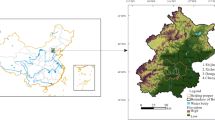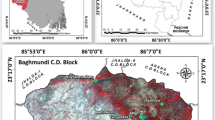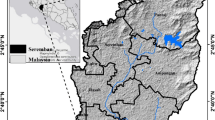Abstract
Markov chain is one of the most widely used methods for land use change forecasting, however, it’s a non-spatial model and few papers have discussed the effects of time-duration on its performance. In this paper, we first present the primary methodologies of the Spatial-Markov model, which endows the ordinary Markov chain with spatial dimension using spatial analysis techniques, and then explore the effects of forecasting time-duration on the model’s performance. By taking Shandong province, China as a case study area, land use maps in 1990, 1995, 2000, 2005 and 2010 were created using on Landsat images and then the Spatial-Markov model was developed at 1 km spatial scale. In detail, we repeatedly run the model by choosing different initial time points and the same time step (five year interval) to simulate the spatial-temporal dynamics of land use change from 1990 to 2010. The forecasting results of a single run included a stack of ratio scale images and a derived nominal scale image, χ 2 test and Kappa coefficient were adopted to evaluate their accuracy respectively. It turned out that the Spatial-Markov model could achieve very good performance for short period forecasting. For the case study, it was quite qualified for the prediction of three time steps (up to 15 years) or more within which the results had much high reliability, however, time-duration of forecasting had much significant impact on the model’s performance, the longer the forecasting duration, the lower the model’s accuracy.





Similar content being viewed by others
References
Batisani, N., & Yarnal, B. (2009). Urban expansion in centre county, Pennsylvania: spatial dynamics and landscape transformations. Appl Geogr, 29, 235–249.
Bell, E. J. (1974). Markov analysis of land use change—an application of stochastic processes to remotely sensed data. Socio Econ Plan Sci, 8, 311–316.
Bracchetti, L., Carotenuto, L., & Catorci, A. (2012). Land-cover changes in a remote area of central Apennines (Italy) and management directions. Landsc Urban Plan, 104, 157–170.
Coppedge, B., Engle, D., & Fuhlendorf, S. (2007). Markov models of land cover dynamics in a southern Great Plains grassland region. Landsc Ecol, 22, 1383–1393.
Eastman, J. R. (2003). IDRISI Kilimanjaro—Guide to GIS and Image Processing. Worcester: Clark Labs.
Fan, F. L., Wang, Y. P., & Wang, Z. S. (2008). Temporal and spatial change detecting (1998–2003) and predicting of land use and land cover in core corridor of Pearl River Delta (China) by using TM and ETM + images. Environ Monit Assess, 137, 127–147.
He, M., Zhao, B., Ouyang, Z., Yan, Y., & Li, B. (2010). Linear spectral mixture analysis of Landsat TM data for monitoring invasive exotic plants in estuarine wetlands. Int J Remote Sens, 31, 4319–4333.
Heiko, B. (2000). Markov chain models for vegetation dynamics. Ecol Model, 126, 139–154.
Jantz, C. A., Goetz, S. J., Donato, D., & Claggett, P. (2010). Designing and implementing a regional urban modeling system using the SLEUTH cellular urban model. Comput Environ Urban Syst, 34, 1–16.
Jokar Arsanjani, J., Helbich, M., Kainz, W., & Darvishi Boloorani, A. (2013). Integration of logistic regression, Markov chain and cellular automata models to simulate urban expansion. Int J Appl Earth Obs Geoinf, 21, 265–275.
Luo, G., Yin, C., Chen, X., Xu, W., & Lu, L. (2010). Combining system dynamic model and CLUE-S model to improve land use scenario analyses at regional scale: a case study of Sangong watershed in Xinjiang, China. Ecol Complex, 7, 198–207.
Maeda, E. E., Pellikka, P. K. E., Siljander, M., & Clark, B. J. F. (2010). Potential impacts of agricultural expansion and climate change on soil erosion in the Eastern Arc Mountains of Kenya. Geomorphology, 123, 279–289.
Mas, J. F., Puig, H., Palacio, J. L., & Sosa-López, A. (2004). Modelling deforestation using GIS and artificial neural networks. Environ Model Softw, 19, 461–471.
Mitsova, D., Shuster, W., & Wang, X. (2011). A cellular automata model of land cover change to integrate urban growth with open space conservation. Landsc Urban Plan, 99, 141–153.
Mondal, P., & Southworth, J. (2010). Evaluation of conservation interventions using a cellular automata-Markov model. For Ecol Manag, 260, 1716–1725.
Oguz, H., & Zengin, M. (2011). Analyzing land use/land cover change using remote sensing data and landscape structrue metrics: a case study of Erzurum, Turkey. Fresenius Environ Bull, 20, 3258–3269.
Omar, N. Q., Ahamad, M. S. S., Hussin, W. M. A. W., Samat, N., & Ahmad, S. Z. B. (2013). Markov CA, multi regression, and multiple decision making for modeling historical changes in Kirkuk City. Iraq J Indian Soc Remote Sens, 1–14.
Peterson, L. K., Bergen, K. M., Brown, D. G., Vashchuk, L., & Blam, Y. (2009). Forested land-cover patterns and trends over changing forest management eras in the Siberian Baikal region. For Ecol Manag, 257, 911–922.
Pijanowski, B. C., Brown, D. G., Shellito, B. A., & Manik, G. A. (2002). Using neural networks and GIS to forecast land use changes: a land transformation model. Comput Environ Urban Syst, 26, 553–575.
Pontius, R. G., Jr., Cornell, J. D., & Hall, C. A. S. (2001). Modeling the spatial pattern of land-use change with GEOMOD2: application and validation for Costa Rica. Agric Ecosyst Environ, 85, 191–203.
Rafiee, R., Mahiny, A. S., Khorasani, N., Darvishsefat, A. A., & Danekar, A. (2009). Simulating urban growth in Mashad City, Iran through the SLEUTH model (UGM). Cities, 26, 19–26.
Rahman, A., Kumar, S., Fazal, S., & Siddiqui, M. A. (2012). Assessment of land use/land cover change in the North-West District of Delhi using remote sensing and GIS techniques. J Indian Soc Remote Sens, 40, 689–697.
Rounsevell, M. D. A., & Reay, D. S. (2009). Land use and climate change in the UK. Land Use Policy, 26. Suppl, 1, S160–S169.
Sang, L., Zhang, C., Yang, J., Zhu, D., & Yun, W. (2011). Simulation of land use spatial pattern of towns and villages based on CA–Markov model. Math Comput Model, 54, 938–943.
Shamsudheen, M., Dasog, G. S., & Tejaswini, N. B. (2005). Land use/land cover mapping in the coastal area of North Karnataka using remote sensing data. J Indian Soc Remote Sens, 33, 253–257.
Siciliano, G. (2012). Urbanization strategies, rural development and land use changes in China: a multiple-level integrated assessment. Land Use Policy, 29, 165–178.
Tayyebi, A., Pijanowski, B. C., & Tayyebi, A. H. (2011). An urban growth boundary model using neural networks, GIS and radial parameterization: an application to Tehran, Iran. Landsc Urban Plan, 100, 35–44.
Thapa, R. B., & Murayama, Y. (2011). Urban growth modeling of Kathmandu metropolitan region, Nepal. Comput Environ Urban Syst, 35, 25–34.
Wang, G. Q., Song, J., Xue, B. L., Xu, X. Y., & Otsuki, K. (2012). Land use and land cover change of hulun lake nature reserve in inner Mongolia, China: a modeling analysis. J Fac Agric Kyushu Univ, 57, 219–225.
Yagoub, M., & Kolan, G. R. (2006). Monitoring coastal zone land use and land cover changes of Abu Dhabi using remote sensing. J Indian Soc Remote Sens, 34, 57–68.
Zhang, R., Tang, C., Ma, S., Yuan, H., Gao, L., & Fan, W. (2011). Using Markov chains to analyze changes in wetland trends in arid Yinchuan Plain, China. Math Comput Model, 54, 924–930.
Zheng, X. Q., Zhao, L., Xiang, W. N., Li, N., Lv, L. N., & Yang, X. (2012). A coupled model for simulating spatio-temporal dynamics of land-use change: a case study in Changqing, Jinan, China. Landsc Urban Plan, 106, 51–61.
Acknowledgments
This study was supported by the Knowledge Innovation Program of the Chinese Academy of Sciences (No. kzcx2-yw-224) and the “Strategic Priority Research Program – Climate Change: Carbon Budget and Relevant Issues” of the Chinese Academy of Sciences (No. XDA05130703)
Author information
Authors and Affiliations
Corresponding author
Electronic Supplementary Material
Below is the link to the electronic supplementary material.
ESM 1
(DOC 1406 kb)
About this article
Cite this article
Hou, XY., Wu, L., Lu, X. et al. Effects of Time-Duration on the Performance of the Spatial-Markov Model for Land use Change Forecasting. J Indian Soc Remote Sens 43, 287–295 (2015). https://doi.org/10.1007/s12524-014-0400-x
Received:
Accepted:
Published:
Issue Date:
DOI: https://doi.org/10.1007/s12524-014-0400-x




